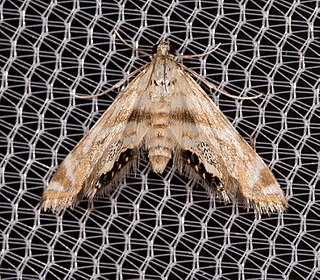
Anageshna is a monotypic moth genus of the Crambidae family described by Eugene G. Munroe in 1956. Its only species, Anageshna primordialis, the yellow-spotted webworm, was described by Harrison Gray Dyar Jr. in 1907. It is found in the US states of Alabama, Arkansas, Arizona, Florida, Georgia, Iowa, Illinois, Kansas, Louisiana, Massachusetts, Maryland, Maine, Minnesota, Missouri, Mississippi, North Carolina, New Hampshire, New Jersey, New York, Ohio, Oklahoma, Pennsylvania, South Carolina, Texas, Virginia and West Virginia.
Geshna is a monotypic moth genus of the family Crambidae described by Harrison Gray Dyar Jr. in 1906. It contains only one species, Geshna cannalis, the lesser canna leafroller, described by Altus Lacy Quaintance in 1898. It is found in North America, where it has been recorded from Florida, Mississippi, South Carolina, North Carolina and Tennessee. It has also been recorded from Costa Rica and Cuba.

Sciota subcaesiella, the locust leafroller moth, is a species of moth of the family Pyralidae. It is found in North America, including Maryland, New Jersey, Oklahoma, Iowa, North Carolina, South Carolina, Georgia, Alabama, Mississippi, Maine, New Hampshire, New York, Massachusetts, Pennsylvania, the District of Columbia, Virginia, Tennessee, Illinois, Missouri, Arkansas, Nova Scotia and Ontario.

Pantographa limata, the basswood leafroller moth, is a moth of the Crambidae family. It is found in North America, including Arkansas, Florida, Georgia, Illinois, Massachusetts, New Hampshire, New York, North Carolina, Ohio, Pennsylvania, Tennessee, Virginia, West Virginia, Wisconsin and Quebec.

Aristotelia roseosuffusella, the pink-washed aristotelia, clover aristotelia moth or garden webworm, is a moth in the family Gelechiidae. It is found in North America, including Alabama, Georgia, Illinois, Kentucky, Maryland, Massachusetts, Michigan, New Jersey, Oklahoma, Ontario, South Carolina, Tennessee and Virginia. The species was first described by James Brackenridge Clemens in 1860.

Moodna ostrinella, the darker moodna moth, is a species of snout moth in the genus Moodna. It was described by James Brackenridge Clemens in 1860, and is known from North America, including Alabama, Florida, Illinois, Maine, Maryland, Massachusetts, Michigan, Minnesota, New Brunswick, New Jersey, New York, Ohio, Oklahoma, Ontario, Pennsylvania, Quebec, South Carolina, Tennessee, Texas and West Virginia.
Argyrotaenia tabulana, the jack pine tube moth or lodgepole needletier moth, is a species of moth of the Tortricidae family. It is found in North America, where it has been recorded from Alabama, Arkansas, British Columbia, Florida, Georgia, Indiana, Louisiana, Maine, Maryland, Massachusetts, Mississippi, New Jersey, New York, North Carolina, Ohio, Oklahoma, Pennsylvania, South Carolina and West Virginia.
Argyrotaenia mariana, the gray-banded leafroller moth, is a species of moth of the Tortricidae family. It is found in North America, where it has been recorded from Connecticut, Florida, Georgia, Illinois, Indiana, Kentucky, Maine, Maryland, Massachusetts, New Brunswick, New Hampshire, New York, North Carolina, Ohio, Ontario, Pennsylvania, Quebec, Tennessee and West Virginia.
Argyrotaenia juglandana, the hickory leafroller moth, is a species of moth of the Tortricidae family. It is found in North America, where it has been recorded from Alabama, Arkansas, Florida, Illinois, Indiana, Kentucky, Louisiana, Maryland, Mississippi, Missouri, New Hampshire, New York, North Carolina, Ohio, Ontario, Pennsylvania, Quebec, Tennessee, Texas, West Virginia and Wisconsin. The habitat consists of deciduous woodlands and parks where hickory grows.

Choristoneura parallela, the parallel-banded leafroller moth, is a species of moth of the Tortricidae family. It is found in North America, where it has been recorded from California, Florida, Georgia, Indiana, Kentucky, Maine, Maryland, Michigan, Mississippi, New Jersey, North Carolina, Ohio, Oklahoma, Quebec, Saskatchewan, South Carolina, Tennessee, Virginia and West Virginia.

Petrophila fulicalis is a moth in the family Crambidae. It was described by James Brackenridge Clemens in 1860. It is found in North America, where it has been recorded from Alabama, Florida, Indiana, Maine, Maryland, Michigan, New York, North Carolina, Ohio, Oklahoma, Ontario, Pennsylvania, Tennessee and West Virginia.
Acleris chalybeana, the lesser maple leafroller moth, is a species of moth of the family Tortricidae. It is found in North America, where it has been recorded from Arkansas, Connecticut, Florida, Illinois, Indiana, Kentucky, Maine, Maryland, Mississippi, New Hampshire, New Jersey, New York, North Carolina, Ohio, Ontario, Pennsylvania, Quebec, South Carolina, Tennessee, West Virginia and Wisconsin.

Sciota uvinella, the sweetgum leafroller moth, is a species of snout moth in the genus Sciota. It was described by Ragonot in 1887. It is found in North America, where it has been recorded from New Jersey to Florida, west to Texas and Kentucky.
Lygropia tripunctata, the sweetpotato leafroller, is a moth in the family Crambidae. It was described by Johan Christian Fabricius in 1794. It is found in the United States, where it has been recorded from Texas to South Carolina and Florida. It is also found from the West Indies and Central America to Brazil.

Dichomeris flavocostella, the cream-edged dichomeris moth, is a moth in the Gelechiidae family. It was described by James Brackenridge Clemens in 1860. It is found in North America, where it has been recorded from southern Quebec and Maine to Florida, west to Texas and north to Manitoba.
Holophysis emblemella is a moth of the Gelechiidae family. It was described by James Brackenridge Clemens in 1860. It is found in North America, where it has been recorded from New York south to Florida. Records include Alabama, Illinois, Maryland, Mississippi, North Carolina, Pennsylvania, South Carolina, Tennessee, Wisconsin, Kentucky and Ohio.

Aristotelia rubidella is a moth of the Gelechiidae family. It was described by James Brackenridge Clemens in 1860. It is found in North America, where it has been recorded from Alabama, Alberta, Arkansas, British Columbia, California, Florida, Georgia, Illinois, Indiana, Iowa, Kentucky, Louisiana, Maine, Manitoba, Maryland, Massachusetts, Michigan, Mississippi, New Jersey, North Carolina, Ohio, Oklahoma, Ontario, Quebec, South Carolina, Tennessee, Texas, Virginia, Washington, West Virginia and Wisconsin.

Olethreutes permundana, the raspberry leafroller, is a species of tortricid moth in the family Tortricidae. It is found in the eastern United States, south-eastern Canada and north-western North America. The species was described by James Brackenridge Clemens in 1860.
















